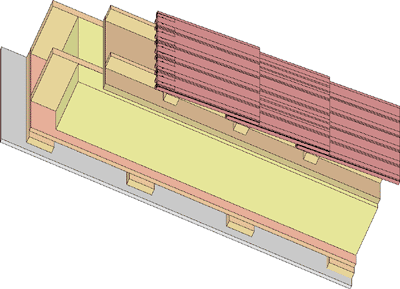Geprüftes/zugelassenes Bauteil
pitched roof sdrhzi04a-10
pitched roof timber frame construction, ventilated, with dry lining, not suspended
Building physical assessment
| Fire performance | REI | 30 |
|---|---|---|
|
maximum span = 5 m; maximum load Ed,fi = 2,62 kN/m² (rafter 60/200 without roofing, counter battens and battens)
Classified by HFA Classified by HFA
Fire performance Germany
Classification: F30
Load Ed,fi according to the German certification document
Proof: DIN 4102-4:2016-05, Tabelle 10.19, Zeile 1
|
||
| Thermal performance | U | 0,16 W/(m2K) |
| Diffusion | adequate | |
|
Calculated by TUM
|
||
| Acoustic performance | Rw (C;Ctr) | 54 dB (-1; -7) |
| Ln,w (Cl) | ||
|
Rating by Müller-BBM
|
||
| Mass per unit area | m | 105,5 kg/m2 |
|
Calculation based on gypsum plaster board type DF GKF
|
||
data sheet pitched roof
sdrhzi04a-10 (pdf, 250 KB)
Note
The design of the under-roof construction and of the counter-battens have to be specified according to the roof pitch and the national requirements.
Only for registered members after logging in.


Register of building materials used for this application, cross-section (from outside to inside)
| Thickness [mm] | Building material | Thermal performance | Reaction to fireklasse EN | ||||
|---|---|---|---|---|---|---|---|
| λ | μ min – max | ρ | c | ||||
| A | concrete roof tile or tiled roof | 2100 | A1 | ||||
| B | 30,0 | spruce wood battens (30/50) | 0,120 | 50 | 450 | 1,600 | D |
| C | 50,0 | spruce wood counter battens (Austria: minimum height 50 mm), Germany 30 mm | 0,120 | 50 | 450 | 1,600 | D |
| D | 22,0 | softboard [045; 250] - rigid underlay | 0,045 | 5 | 250 | 2,100 | E |
| E | 240,0 | construction timber (80/..; e=625) | 0,120 | 50 | 450 | 1,600 | D |
| F | 240,0 | Wood fibre insulation [039; 45] | 0,039 | 1-2 | 45 | 2,100 | E |
| G | 15,0 | OSB (sealed with airtight tape) | 0,130 | 200 | 600 | 1,700 | D |
| H | 24,0 | spruce wood cladding with spacing of cladding boards(24/100); a=400 | 0,120 | 50 | 450 | 1,600 | D |
| I | 12,5 | gypsum plaster board type DF or | 0,250 | 10 | 800 | 1,050 | A2 |
| I | 12,5 | gypsum fibre board | 0,320 | 21 | 1000 | 1,100 | A2 |
Ecological rating (per m2 construction area)
Details of sustainability rating...
| Global warming potential | Share of renewable Primary Energy | Resources | |||||||||||
|---|---|---|---|---|---|---|---|---|---|---|---|---|---|
| Lifecycle Phase |
GWP-F [kgCO2Äqv.] |
GWP-B [kgCO2Äqv.] |
GWP-T [kgCO2Äqv.] |
PERE [MJ] |
PERM [MJ] |
PERT [MJ] |
PENRE [MJ] |
PENRM [MJ] |
PENRT [MJ] |
AP [kgSO2Äqv.] |
EP [kgPO4Äqv.] |
ODP [kgR11Äqv.] |
POCP [kgEthenÄqv.] |
| A1 - A3 | 32,511 | -71,392 | -38,880 | 114,427 | 732,802 | 847,228 | 457,938 | 36,093 | 494,031 | 0,114 | 0,051 | 2.7980393E-6 | 0,024 |
Details of sustainability rating...
| Resources | |||||||||||
|---|---|---|---|---|---|---|---|---|---|---|---|
| Lifecycle Phase |
GWP [kgCO2Äqv.] |
AP [kgSO2Äqv.] |
EP [kgPO4Äqv.] |
ODP [kgR11Äqv.] |
POCP [kgEthenÄqv.] |
PERE [MJ] |
PERM [MJ] |
PERT [MJ] |
PENRE [MJ] |
PENRM [MJ] |
PENRT [MJ] |
| A1 - A3 | -64,008 | 0,131 | 0,026 | 8.2E-7 | 0,033 | 415,182 | 1127,471 | 1543,930 | 841,123 | 48,328 | 889,599 |
| C1 - C4 | 107,994 | 0,007 | 0,001 | 7.71E-8 | 0,001 | 3,419 | -1122,290 | -1118,872 | 37,314 | -47,386 | -10,072 |
| A1 - C4 | 45,015 | 0,141 | 0,028 | 9.04E-7 | 0,033 | 419,677 | 5,440 | 426,393 | 892,800 | 0,994 | 893,942 |
Last update 02.08.2023/hfa.eco2soft